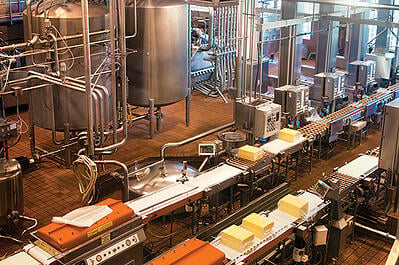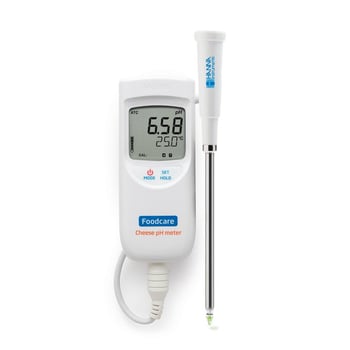
Measuring pH during cheese making is a critical quality Control (QC) step. The pH offers an indication of contamination from bacteria or chemicals while also providing a convenient method to estimate the acid development of a dairy product. As there are a myriad of different sampling methods, electrode care guidelines, and electrode designs, determining best practices for measuring pH during cheese making can be a challenge.
Quick Guide to Measuring pH During Cheese Making
 The production of cheese begins with the metabolism of milk by microbial cultures. These cultures ferment the milk, producing lactic acid from the natural sugars. This fermentation process causes a decrease in pH and allows for flavors to develop.
The production of cheese begins with the metabolism of milk by microbial cultures. These cultures ferment the milk, producing lactic acid from the natural sugars. This fermentation process causes a decrease in pH and allows for flavors to develop.
Next, the milk is separated into solid and liquid components through the use of rennet. Rennet is an enzyme complex that is responsible for the curdling of proteins in milk. The resulting solid component is known as curd, and the liquid component is called whey.
Once the milk is coagulated, the curd is fermented until it reaches a pH of 6.4. It is subsequently separated from the whey and left to form into a mat. At this point, the mat is cut into sections and layered to expel more liquid.
Fermentation continues during this stage until the pH reaches 5.1 to 5.5; then the cheese is salted or brined. Depending on which style of cheese you are making, additional treatment may be performed before the product is stored, aged, and packaged for distribution.
Throughout the process, measuring pH during cheese making is critical to ensure consistent fermentation and food safety. If pH is too low the cheese may be prone to a brittle or pasty texture, as well as the growth of mold after packaging; if the pH is too high, the cheese may become too firm and can be dangerous for consumption due to the risk of pathogen formation.
Customer Spotlight
Challenge
A local creamery contacted Hanna Instruments to acquire a pH meter that would aid in their quality control protocol. Our technical team recommended an electrode supplied with the meter be resistant to clogging of the junction, as the customer previously experienced erratic readings after taking measurements in viscous emulsions.
Recommendation

Hanna offered the Portable Cheese pH Meter - HI99165 is a durable, waterproof, and portable pH and temperature meter designed specifically for cheese analysis.
Easy Calibration
Automatic calibration is performed at one or two points with two sets of buffers. All calibration and measurement readings are automatically compensated for temperature variations.
Simple to use
The split-level LCD displays both pH and temperature readings, along with indicators for reading stability, battery percentage, and calibration instructions.
Specialized pH electrode
The HI99165 uses the FC242D stainless steel body, amplified pH electrode that offers numerous features that improve pH testing for cheese producers.
That's why we've dedicated our blog as a helpful resource for you to use! Catch up on the latest products, explore industry trends, discover testing tips, learn how to improve results, and more. Got questions? Email sales@hannainst.com.


